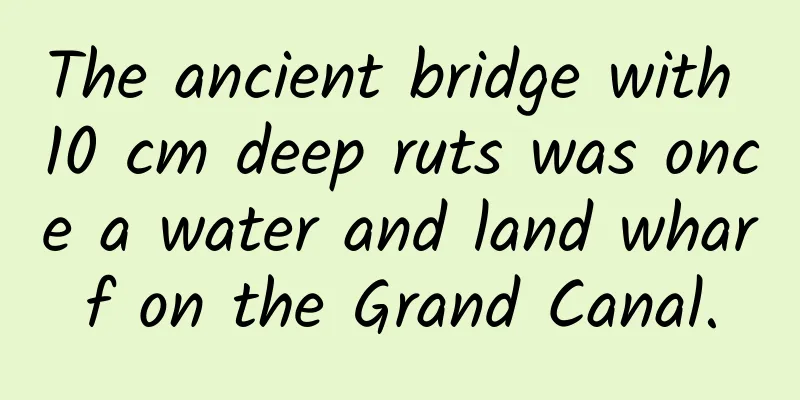The ancient bridge with 10 cm deep ruts was once a water and land wharf on the Grand Canal.

|
The plum rains have cleared, and the summer breeze is mild. There are many cicadas in the tall willows. The small garden terrace and pavilion are far away from the pond. Fishes play with the new lotus leaves. On the south bank of the Yellow River embankment, passing through the once busy streets and densely packed houses, approaching a green area at the east end of the village, and winding forward along the path, what comes into view is Zhengzhou's thousand-year-old bridge - Huiji Bridge. The 11th China Flower Expo in 2025 will be held at the site of the Tongji Canal of the Sui and Tang Grand Canal This year marks the 10th anniversary of the successful application of the Grand Canal of China for World Heritage status. Since King Fuchai of Wu excavated the Hang Canal in 486 BC, the Grand Canal of China has gone through more than 2,500 years and developed into an artificial waterway with a total length of 3,200 kilometers, connecting five major water systems and crossing eight provinces (municipalities). On June 22, 2014, the Grand Canal of China was selected into the World Cultural Heritage List. The heritage sites of the Henan Grand Canal listed as a World Cultural Heritage involve five provincial cities, namely Zhengzhou, Luoyang, Shangqiu, Anyang and Hebi, as well as Huaxian, a provincially-administered county, including the Huiluo Warehouse Site and Hanjia Warehouse Site in Luoyang City, the Zhengzhou section of the Tongji Canal, the Nanguan section of the Tongji Canal in Shangqiu, the Xiayi section of the Tongji Canal in Shangqiu, the Huaxian-Junxian section of the Wei River (Yongji Canal), and the Liyang Warehouse Site in Junxian, a total of seven heritage sites. The Huiji Bridge is not only a precious relic on the Tongji Canal of the Grand Canal of the Sui and Tang Dynasties, but also an important witness to the thousand-year changes of the ancient city of Zhengzhou. Now, the right to host the 11th China Flower Expo in 2025 has been chosen by Zhengzhou, and the site is the Tongji Canal Ruins of the Grand Canal of the Sui and Tang Dynasties, which is also the only cultural core area in my country that brings together "Yellow River Civilization", "Canal Culture" and "Central Plains History". The Bianhe Ruins Park will serve as the main venue of the Expo. This national-level flower event with the largest scale, highest level and widest influence in my country will also bring more new vitality to the ancient village of Huijiqiao. According to the planning and design of the Grand Canal National Cultural Park (Huiji Section), Huijiqiao Village is located in the section of the Bianhe River Heritage Park to be built. The Grand Canal Cultural Zone has a planned area of 21 square kilometers, extending from Provincial Highway S312 in the north to the south bank of the Suoxu River in the south, from Wenhua Road in the east to Jiangshan Road in the west, and is built around key projects such as the Bianhe River Heritage Park, the Yellow River Gate, and the Yellow River National Museum. Willow branches sway, pavilions stand tall, and blue brick carved railings are hidden among them. Standing on this stone slab bridge that has been covered with dust for thousands of years, looking at the deep ancient road of the Grand Canal of the Sui and Tang Dynasties under the bridge, it seems as if you have returned to the days when thousands of houses were brightly lit and merchants were prosperous, and you can hear the gurgling water and the noisy streets of the past. When did the rainbow fall from the sky? It started in the Sui and Tang dynasties When will the rainbow fall from the sky? Huiji’s good name will spread everywhere. We are already relying on Cihang to save everyone, and we will follow Wang Luozu's instructions. The river is full of flowers, and willows on both sides are shrouded in mist. Cars and horses pass by the green stream, and the bridge seems to be ascending to heaven. ——Cui Qi, Qing Dynasty The prosperity of the two sides of Huiji Bridge can be seen in the poem about the bridge written by Cui Qi, a county magistrate in the Qing Dynasty. At that time, the people on both sides of Huiji Bridge were rich and the trade was prosperous. "The grain transport ships traveled back and forth for thousands of miles without interruption", "public grain transport, private business travel", salt, tobacco, medicinal materials, silk, and all kinds of sundries were available. It is recorded in the Xingze County Annals during the Qianlong Period of the Qing Dynasty: "The Huiji Bridge is about eight miles east of the county. In the past, the Jialu River flowed under it, but now the river has moved south and only the stone bridge remains. Thousands of families live nearby, and most of the trade and migration takes place here." It has always been known as "a place of elegance and generosity, and a place of cultural heritage and abundant natural resources." Since Cui Qi found it difficult to determine the exact construction date of the bridge, he had the question "when did the rainbow fall from the sky?", which also indirectly shows that Huiji Bridge has a long history. In fact, Huiji Bridge is a stone bridge on the Grand Canal of the Sui and Tang Dynasties. In order to consolidate national unity and strengthen exchanges between the north and the south, the Sui and Tang Dynasties dug the Tongji Canal of the Grand Canal from the 6th to the 10th century AD, forming a water transport channel connecting the Central Plains and the Jiangnan region. According to documents and archaeological excavations, the eastern section of the Tongji Canal starts from the south bank of the Yellow River in Zhengzhou in the north, diverts the Yellow River water southward, flows through Huijiqiao Village and Diwan Village, turns east, and flows into the Huai River through the Suoxu River. Therefore, in history, the Tongji Canal was also called the Huiji River, and the stone bridge built on the river was named after the water. Huiji Bridge was once a hub where water and land transportation met, and it was prosperous for a time, and Huiji Bridge Village was formed based on it. Wang Jun, a staff member of the Cultural Heritage and Safety Section of the Guxing Han Dynasty Iron Smelting Site Branch of Zhengzhou Museum, told reporters that during the Jiajing period of the Ming Dynasty, official Zhang Shuji repaired the bridge and named it "Huiji Bridge", which means to benefit pedestrians and villagers. The river under the bridge has been through the Sui, Tang, Yuan, Ming and Qing dynasties, and was silted up in modern times. It is not only an important water and land port, but also one of the "Eight Scenic Spots of Xingze" According to the illustration of Huiji Long Bridge in the Eight Scenic Spots of Xingze in the "Annals of Xingze County", there are six pillars and six stone railings on each side of the bridge, a lion-faced image is carved in the middle of the bridge, and there are spectacular bridge towers at both ends, all made of finely carved bluestone. The three-arch bridge is 5 meters wide and about 40 meters long from east to west. There are stone railings with finely carved patterns on both sides, and spectacular bridge towers at both ends. With the abandonment of the Grand Canal, Huiji Bridge became silted up and abandoned. After years of historical changes and wind and rain, the bridge towers on both sides are no longer there, the guardrails have collapsed, and the bridge deck is overgrown with weeds. Wang Jun told reporters that since 2013, Huiji District has demolished many residential houses and factory buildings that have the greatest impact on the environment around Huiji Bridge, invested nearly 10 million yuan, repaired the Huiji Bridge in accordance with its original appearance in the "Xingze County Chronicles", improved the surrounding environment, built a stele corridor and pavilion, and relocated the sewage and water networks to restore the Huiji Bridge to its "original appearance." "According to the information, in the 1950s, the railings on both sides of the bridge were still standing intact, and the three-arch bridge was clearly visible. According to the elderly in the village, before the founding of New China, the stone railings and pillars of the bridge could still be seen. When we were repairing it, we could see some of them still remaining on both sides." Wang Jun said. What kind of car can leave a 10cm deep rut? Is the bridge an ETC channel? Almost everyone who has been to Huiji Bridge will be surprised by the two 8 to 10 cm deep ruts in the middle of the bridge deck. How big a car and how many cars must have passed to create them? With questions in mind, a reporter from Dahe.com interviewed Yan Shuguang, deputy director of Zhengzhou Museum. "What you see is vicissitudes, and what you think of is prosperity. As a former east-west road along the Yellow River, such deep wheel tracks are enough to show that it was once bustling with traffic, at least during the Ming and Qing dynasties." Yan Shuguang said, "After the Qin Dynasty unified China, it implemented 'same track for vehicles, same writing for books', that is, the same track and unified writing were adopted throughout the country. It is speculated that when Huiji Bridge was in use, both sides were 'sidewalks', and vehicles naturally passed in the middle. After hundreds of years, it is not surprising that there are such deep wheel tracks." In addition, some people speculate that the bridge towers on both sides of the bridge were checkpoints at the time, used to control traffic and passenger flow, similar to the current "ETC channel", and "only vehicles that meet the regulations can pass." Standing here for a thousand years, we have witnessed the canal drying up and the dynasties changing. Now the villagers of Huiji Bridge have left due to the demolition. They are just the passing visitors of the thousand-year-old stone bridge. But "the faces of people are gone, but the peach blossoms still smile in the spring breeze". When you come, I will welcome you. When you leave, I will not see you off! |
<<: Which is healthier: eating a lot and not gaining weight or drinking water and gaining weight?
>>: Feel like your brain isn't working anymore? Here are 11 brain-boosting foods →
Recommend
The more you walk, the lower your risk of death?
Insufficient physical activity affects more than ...
Liquid rocket reuse, where to focus next?
Recently, a type of liquid oxygen-kerosene engine...
An octogenarian is restricted from going to the hospital due to salt restriction in order to control high blood pressure? Is it true that lighter food is not better?
Salt is very important to the human body, and acu...
Zhang Peichao, the leader of the Young Turks: A psychotherapy course specifically for Chinese people (20 micro-courses) Audio course
Zhang Peichao, the leader of the Young Turks: A p...
Practical self-media toolkit (software + tutorial + material + subtitles) collection
With the continuous popularization of China's...
I can't get up for work and wake up too early on vacation. Why is this happening?
Not being able to get up for work and waking up t...
The world's first! Tsinghua team successfully developed a "memristor chip"!
Recently, the team of Professor Wu Huaqiang and A...
The promotion effect is not good, maybe you didn’t think it through at the beginning
Whether it is user operation , product operation ...
Measuring wind, clouds and rain, how capable is weather radar?
Author: Haiyueming Studio Weather radar and weath...
World Bank: Harnessing the promise of artificial intelligence to achieve shared prosperity
Not a day goes by that we don’t see a headline ab...
How to get a higher ranking in Google keyword advertising promotion?
Google Search has more than 80% market share in t...
8 ways to drive traffic to public accounts through short videos
Friends who work on short video columns are no st...
Basic dance moves lead to lower limb paralysis? Dangerous "bending back"
|| || Written by reporter Lv Bingxin Photo and te...
As Xiaomi Motors is about to go public, Geely sets up a gun and launches a precise sniper attack, perhaps because one person at a time
After announcing the upcoming release of the SU7 ...
The world's fifth person cured of AIDS has appeared. Can the method of conquering AIDS be replicated?
On February 20, 2023, researchers from the Univer...









